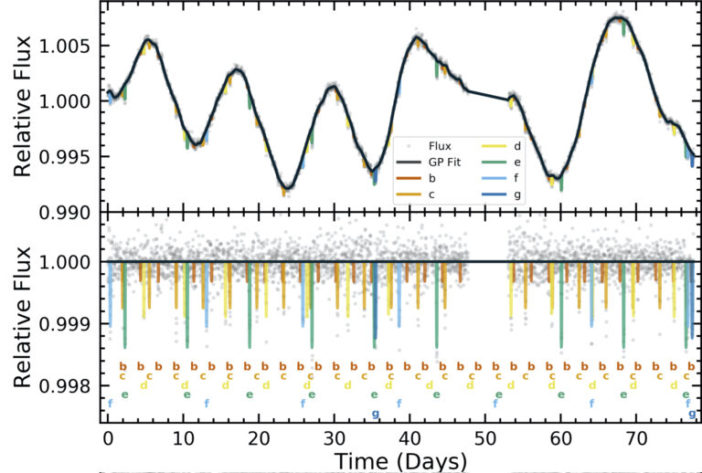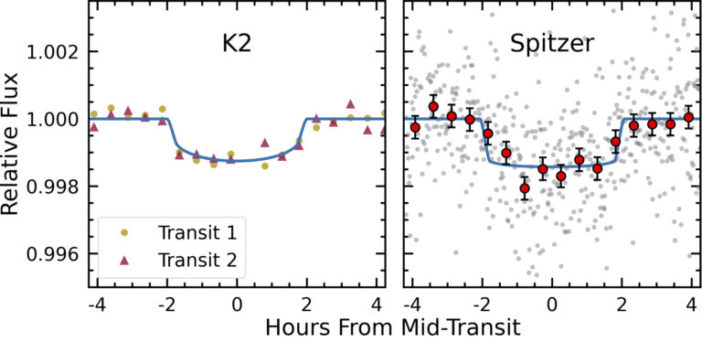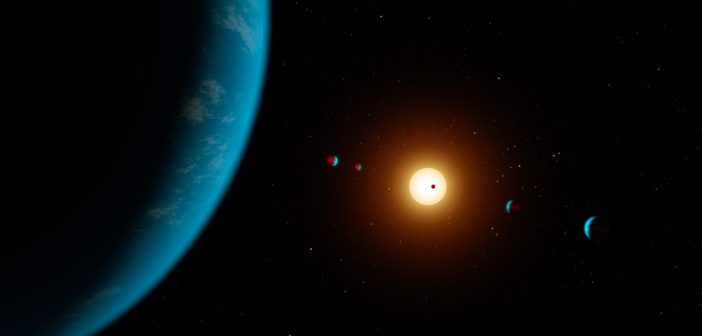Editor’s note: Astrobites is a graduate-student-run organization that digests astrophysical literature for undergraduate students. As part of the partnership between the AAS and astrobites, we occasionally repost astrobites content here at AAS Nova. We hope you enjoy this post from astrobites; the original can be viewed at astrobites.org.
Title: K2-138 g: Spitzer Spots a Sixth Planet for the Citizen Science System
Authors: Kevin K. Hardegree-Ullman et al.
First Author’s Institution: Caltech / IPAC-NExScI
Status: Published in AJ
What do you get when you have five exoplanets that sing and add a sixth? Why, the K2-138 system of course!
Discovered in 2018 through the Exoplanet Explorers program, K2-138 was the first system found by citizen scientists with K2, the extension mission of the original Kepler program. By spotting regular dips in K2 light curves, the citizen scientists were able to find four sub-Neptune exoplanets, with an additional super-Earth discovered after further analysis. All the planets were found to be in a near perfect 3:2 resonance chain, meaning their orbital periods follow successive ratios of each other — as discussed in this Astrobite.
But, the K2-138 system had more to offer! The analysis that identified the super-Earth also spotted two additional dips in the K2 light curves, roughly 42 days apart. Dips like these, shown by the dark blue lines, and the letter g, in Figure 1, indicate that a sixth planet might transit K2-138, waiting to be confirmed by the authors of today’s paper.

Figure 1: The top panel shows the raw K2 light curve, while the bottom panel shows the same light curve flattened to highlight the planetary transits. In both panels transits of each planet in the system are shown with colored lines. The potential planet g is represented by the darkest blue lines. [Adapted from Hardegree-Ullman et al. 2021]

Figure 2: The transit light curves from the K2 and Spitzer observations. In the left panel, yellow circles and red triangles show each of the two transits seen by K2. In the right panel, grey points show the Spitzer observations. The red circles show the data binned to 20 minute intervals, showing the drop in flux caused by the transiting planet. In both panels, the blue line gives the fitted transit model. [Adapted from Hardegree-Ullman et al. 2021]
While the transit durations of the two light curves in Figure 2 are nearly identical, the Spitzer data show K2-138g to have a slightly larger transit depth, and hence radius. As the two transit lengths are consistent within one sigma, the authors note that the limited number of data points in the K2 transits mean that any outliers could skew the results, causing the slight discrepancy with Spitzer.
The More the Merrier
While planets b, c, d, and e are in near 3:2 resonance with their respective neighbours, the outer planets f and g are not. Given this fact, along with the sizeable gap in orbital period between f and g, could there be additional planets in the system yet to be discovered? It seems possible. If the pattern of resonances continued beyond planet f, resonant orbits would be expected at periods of around 20 and 30 days, but more observations are needed to confirm whether any such planets exist.

Figure 3: The orbital spacings of a selection of multiplanet systems, in order of the size of their stellar hosts from largest at the top. Each system is shown by a coloured line with a width corresponding to the size of the host star. Transiting planets are represented by circles scaled to the line width, enlarged 10x for clarity. Non-transiting planets are shown in blue. The large separation between the two outer planets of K2-138 is similar to that seen in the Kepler-11, Kepler-20, HD 219134, and Kepler-80 systems. [Hardegree-Ullman et al. 2021]
A Benchmark System
With its tightly packed resonant inner planets and abundance of sub-Neptunes, the authors argue that the K2-138 system is a more than worthy target of follow-up observations. The inner planets provide an excellent opportunity to study their potential transit-timing variations (TTVs) — discrepancies in the regular periods of planets — and observations have already been scheduled. Alongside radial velocity (RV) data, this could enable precise mass measurements and see the potential discovery of additional planets. While the planets have atmospheric signals too small to be studied with the James Webb Space Telescope, they are prime targets for the European Space Agency’s upcoming ARIEL mission. The system’s five sub-Neptunes could provide a key testbed for comparative studies of the atmospheres of a planet category not seen in our solar system.
Whatever the future holds, it certainly seems likely that we’ll be hearing more from K2’s most musical system in the years to come!
Original astrobite edited by Brent Shapiro-Albert.
About the author, Lili Alderson:
Lili Alderson is a first year PhD student at the University of Bristol studying exoplanet atmospheres with space-based telescopes. She spent her undergrad at the University of Southampton with a year in research at the Center for Astrophysics | Harvard-Smithsonian. When not thinking about exoplanets, Lili enjoys ballet, film, and baking.

